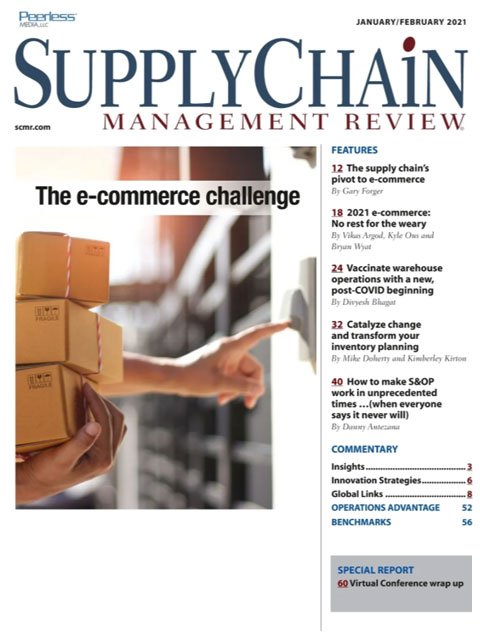Sorry, but your login has failed. Please recheck your login information and resubmit. If your subscription has expired, renew here.
January-February 2021
This morning, I turned on the television and watched the first stretch-wrapped pallets of the just-authorized vaccine being loaded onto a truck at a Pfizer plant in Michigan. From there, the pallets were headed to FedEx’s logistics hub in Memphis where they would be delivered to 153 locations across the 50 states. The event was both historic and mundane: Historic in that the shipments represent the hope of a nation that in the coming months, we’ll begin to put 2020—and COVID—in the rearview mirror; mundane in that this is a scene repeated millions of times a day, without fanfare, in plants and distribution centers across the country. Two of… Browse this issue archive.Need Help? Contact customer service 847-559-7581 More options
Predictive analytics enable supply chain practitioners to anticipate business outcomes—providing they ask the right questions of the technology.
Framing appropriate questions requires professionals to identify the issues that need to be explored, and to understand what can and cannot be modeled using predictive analytics. This combination of business and technical know-how is not always available, however.
Challenges like this were discussed by practitioners and data scientists from a broad range of companies at MIT CTL’s Analytics of the Future Roundtable: Predictive Analytics on November 18, 2020. Enterprises at different stages of development described their approaches to harnessing the predictive power of analytics.
Horses for courses
Understanding the technology’s alchemy can be a stumbling block for executives when deciding which use cases or ideas they want to model. There are four or five types of predictive models commonly used in supply chain applications, and each one has quirks that align it with certain types of problems. Knowing these differences in advance helps to refine the search for use cases and avoid presenting data analytics teams with projects that turn out to be impractical and time-wasting.

This complete article is available to subscribers only.
Log in now for full access or start your PLUS+ subscription for instant access.
SC
MR
Sorry, but your login has failed. Please recheck your login information and resubmit. If your subscription has expired, renew here.
January-February 2021
This morning, I turned on the television and watched the first stretch-wrapped pallets of the just-authorized vaccine being loaded onto a truck at a Pfizer plant in Michigan. From there, the pallets were headed to… Browse this issue archive. Access your online digital edition. Download a PDF file of the January-February 2021 issue.Predictive analytics enable supply chain practitioners to anticipate business outcomes—providing they ask the right questions of the technology.
Framing appropriate questions requires professionals to identify the issues that need to be explored, and to understand what can and cannot be modeled using predictive analytics. This combination of business and technical know-how is not always available, however.
Challenges like this were discussed by practitioners and data scientists from a broad range of companies at MIT CTL’s Analytics of the Future Roundtable: Predictive Analytics on November 18, 2020. Enterprises at different stages of development described their approaches to harnessing the predictive power of analytics.
Horses for courses
Understanding the technology’s alchemy can be a stumbling block for executives when deciding which use cases or ideas they want to model. There are four or five types of predictive models commonly used in supply chain applications, and each one has quirks that align it with certain types of problems. Knowing these differences in advance helps to refine the search for use cases and avoid presenting data analytics teams with projects that turn out to be impractical and time-wasting.
 SUBSCRIBERS: Click here to download PDF of the full article.
SUBSCRIBERS: Click here to download PDF of the full article.
SC
MR


Latest Supply Chain News
- Retail sales see gains in October, reports Commerce and NRF
- Balancing green and speed: Home delivery insights from the pandemic era
- AdventHealth named top healthcare supply chain by Gartner
- Geopolitical readiness in supply chains: Strategic challenges for leaders
- Unlocking retention: The role employee engagement plays
- More News
Latest Podcast

 Explore
Explore
Topics
Software & Technology News
- Nine questions are the key to AI success in building resilient supply chains
- Looking back at NextGen 2024
- AI is moving omnichannel closer to the customer
- How technological innovation is paving the way for a carbon-free future in logistics and supply chains
- Körber Supply Chain Software’s Craig Moore says MercuryGate acquisition is about the customer
- Robotic use grows by 10%
- More Software & Technology
Latest Software & Technology Resources

Subscribe

Supply Chain Management Review delivers the best industry content.

Editors’ Picks





